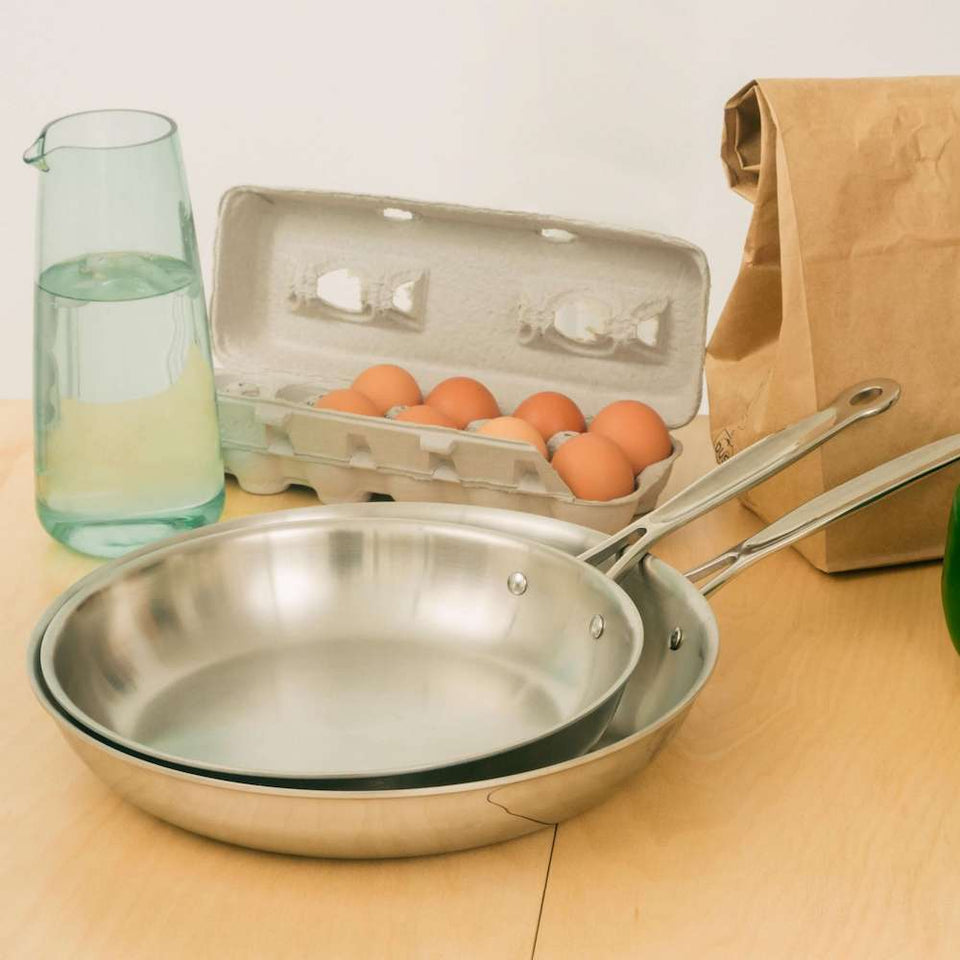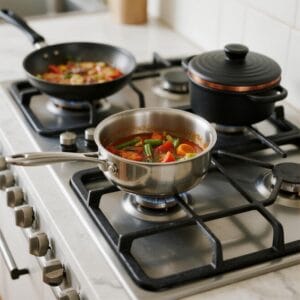Tri-ply cookware is durable, but proper care ensures its longevity and performance.
I’ve realized that while tri-ply cookware is built for durability, it does require some specific care to maintain its shine and functionality. Simple steps like proper cleaning, avoiding harsh abrasives, and using the right utensils can go a long way in preserving its quality.
Tri-ply cookware maintenance involves gentle cleaning, avoiding metal utensils, and preventing extreme temperature changes. To keep tri-ply cookware in top condition, it’s recommended to clean it with mild detergents and soft sponges to avoid scratching the surface. Using non-metal utensils helps protect the finish, while gradually adjusting heat prevents warping and maintains even heat distribution.
From my experience, taking care of tri-ply cookware is straightforward once you follow these practices. By investing a little effort into its maintenance, you can ensure your cookware remains reliable, efficient, and a staple in your kitchen for years to come.

Does Tri-Ply Cookware Require Special Maintenance?
Tri-ply cookware does not require overly complex maintenance, but there are certain practices that can help extend its lifespan. Regular care involves cleaning the cookware after each use, managing heat levels during cooking, and storing it properly to avoid damage.
- Basic Maintenance Needs: Tri-ply cookware is designed to be relatively easy to care for. The most important aspect is cleaning it after every use to avoid food buildup. It is also important to avoid subjecting the cookware to sudden temperature changes, which could lead to warping.
- Regular Care Practices: Hand washing tri-ply cookware with mild dish soap and warm water is recommended. Harsh chemicals and abrasive cleaning pads should be avoided to prevent scratches and maintain the integrity of the stainless steel surface.
- Special Situations: For burnt-on residue or discoloration, special care may be required. Using a baking soda paste or soaking the cookware can help loosen tough stains without damaging the cookware.
What Are the Best Cleaning Products for Tri-Ply Cookware?
Choosing the right cleaning products can make a significant difference in maintaining the quality and appearance of your tri-ply cookware.
- Recommended Cleaning Agents: The best cleaning products for tri-ply cookware include gentle dish soap, warm water, and non-abrasive sponges. These help remove food particles without scratching the stainless steel surface.
- Stainless Steel Cleaners: For maintaining shine, stainless steel cleaners are effective. These specialized products are formulated to remove discoloration and keep the cookware looking new.
- Avoiding Harsh Chemicals: Harsh chemicals and abrasive pads can damage the stainless steel surface. Stick to mild, non-toxic cleaning agents that are food-safe to preserve the cookware’s quality.
- Safe Ingredients: Using cleaning agents that are safe for cookware is essential to avoid leaving harmful residues that could affect food safety.
What Are the Best Methods to Polish Tri-Ply Cookware?
Polishing tri-ply cookware can help maintain its shine and keep it looking new for years. There are a few effective methods to polish your cookware.
- Using Stainless Steel Polish: Stainless steel polish is a great way to restore the original shine of tri-ply cookware. Apply a small amount of polish, rub gently with a soft cloth, and then rinse thoroughly.
- Natural Alternatives: Vinegar and water mixtures can be used as natural alternatives to commercial polish. These are effective in removing discoloration and maintaining the stainless steel surface without introducing chemicals.
- Step-by-Step Process: Apply the polish or vinegar solution, scrub gently in a circular motion, and rinse thoroughly with warm water. Dry the cookware immediately to prevent water spots.
- Frequency of Polishing: Polishing can be done as needed—typically when the cookware starts to look dull. Regular polishing helps maintain the shine and prevents the buildup of discoloration.

Can I Use a Metal Polish on Tri-Ply Cookware?
Using metal polish on tri-ply cookware is possible, but there are important considerations to ensure safety and effectiveness.
- Safety Considerations: Only use metal polishes that are labeled as food-safe. Many metal polishes contain chemicals that may not be suitable for cookware, especially those that come in contact with food.
- Check Product Labels: Always check the product labels to ensure the polish is intended for cookware. Using a polish that is not food-safe could leave harmful residues.
- Proper Application: When applying metal polish, follow the instructions carefully. Apply a small amount, rub it onto the surface, and rinse thoroughly to remove any residue.
- Risks Involved: The main risk of using metal polish is the potential contamination of food if the polish is not properly rinsed off. To avoid this, ensure that all residues are completely removed.
What Are the Risks of Using Metal Polish on Tri-Ply Cookware?
While metal polish can be effective for restoring shine, it also comes with certain risks that should be considered.
- Residue Contamination: Metal polishes may leave residues that can be harmful if ingested. This is why it is crucial to use food-safe polishes and to thoroughly rinse the cookware after polishing.
- Health Concerns: Ingesting chemicals from non-food-safe metal polishes can pose health risks. To minimize these risks, always use polishes intended for use on cookware.
- Proper Rinsing: After using metal polish, rinse the cookware thoroughly with warm water to ensure that no residue is left on the surface.
- Alternatives: If you are concerned about using chemical polishes, consider using natural alternatives like vinegar or baking soda, which are safe and effective.
What Are the Safest Cleaning Methods for Tri-Ply Cookware?
The safest cleaning methods for tri-ply cookware involve using gentle cleaning agents and techniques that do not damage the surface.
- Recommended Cleaning Practices: Use warm water, mild dish soap, and a soft sponge to clean tri-ply cookware. This ensures that food residue is removed without causing scratches.
- Avoid Abrasive Tools: Abrasive sponges or brushes can damage the stainless steel surface, leading to scratches that may compromise the cookware’s performance.
- Temperature Management: Avoid subjecting the cookware to sudden temperature changes, such as placing hot cookware directly under cold water. This can cause warping and damage.
- Gentle Techniques: Use gentle scrubbing techniques and avoid excessive force. This helps maintain the integrity of the stainless steel surface.
How Can I Remove Stubborn Stains from Tri-Ply Cookware?
Stubborn stains can be challenging to remove, but with the right techniques, you can effectively clean your tri-ply cookware without damaging it.
- Soaking Method: Soaking the cookware in warm, soapy water for 15-20 minutes can help loosen stubborn stains. This method is particularly useful for burnt-on food.
- Baking Soda Paste: Create a paste with baking soda and water, then apply it to the stained area. Gently scrub with a soft sponge until the stain is removed.
- Vinegar Application: Vinegar is effective for dissolving burnt-on residue. Apply vinegar to the stained area, let it sit for a few minutes, and then rinse thoroughly.
- Preventing Future Stains: To prevent stains, clean the cookware immediately after use and avoid cooking on excessively high heat, which can cause food to stick.
Does Tri-Ply Cookware Require Special Care Compared to Other Materials?
Compared to other types of cookware, tri-ply has unique care requirements that can make it easier to maintain in some aspects.
- Comparison with Cast Iron: Unlike cast iron, tri-ply cookware does not require seasoning, and it is easier to clean due to its non-reactive stainless steel surface.
- Comparison with Non-Stick: Non-stick cookware is more prone to damage from metal utensils and requires special care to avoid scratching. Tri-ply, on the other hand, is more durable but still benefits from using non-metal utensils.
- Advantages of Tri-Ply: Tri-ply cookware is generally lower maintenance compared to other materials like cast iron and non-stick. It is less prone to rust and does not require special coatings.
- Best Practices: Proper care, such as avoiding high heat and using appropriate cleaning agents, can ensure tri-ply cookware remains in excellent condition.

Are There Any Health Risks Associated with Using Metal Polish on Cookware?
Using metal polish on cookware can pose health risks if not done properly. It’s important to follow safety guidelines to minimize these risks.
- Chemical Residue Risks: Non-food-safe metal polishes can leave residues that may be harmful if ingested. Always use products labeled as safe for cookware.
- Importance of Food-Safe Products: Only use polishes that are certified as food-safe to prevent exposure to harmful chemicals.
- Proper Rinsing: Thoroughly rinse the cookware after using any polish to ensure all residues are removed.
- Safer Alternatives: Consider using natural methods such as vinegar or baking soda, which are safe and effective for polishing cookware.
Tri-ply cookware is versatile and durable, but proper care ensures it performs at its best and lasts longer. Regular cleaning with gentle dish soap, warm water, and non-abrasive sponges is ideal. For restoring shine, food-safe stainless steel polish or natural solutions like vinegar and water work well.
To tackle stubborn stains, soak the cookware in warm, soapy water or apply a baking soda paste to loosen residue without scratching the surface. Avoid harsh scrubbing tools, extreme heat, and sudden temperature changes to maintain its quality.
By following these simple practices, tri-ply cookware remains a reliable, low-maintenance kitchen tool for years, whether you’re a professional chef or a home cook.
Conclusion
Tri-ply cookware does not require special maintenance, but following a few simple care guidelines can significantly extend its lifespan and keep it looking and performing its best. By managing heat, using the right cleaning techniques, and avoiding common mistakes, you can ensure that your tri-ply cookware remains a reliable tool in your kitchen for many years to come. Whether you’re a home cook or a professional chef, proper maintenance of tri-ply cookware will help you get the most out of your investment.
Frequently Asked Questions (FAQs)
- Is tri-ply cookware dishwasher safe?
- Yes, most tri-ply cookware is labeled as dishwasher safe. However, hand washing is recommended to maintain its finish and extend its lifespan.
- Can I use metal utensils with tri-ply cookware?
- It is best to avoid metal utensils to prevent scratching. Use wooden, silicone, or plastic utensils instead.
- How should I clean stubborn stains on tri-ply cookware?
- Soaking the cookware in warm soapy water can help loosen stubborn stains. You can also use a paste of baking soda and water to gently scrub away tougher stains.
- Does tri-ply cookware require seasoning?
- While seasoning is not necessary, occasionally applying a small amount of oil can create a natural non-stick layer that makes cooking and cleaning easier.
- What should I do if my tri-ply cookware gets discolored?
- Discoloration can be removed using a stainless steel polish or a mixture of vinegar and water. This will help restore the cookware’s shine.
- cool before cleaning.
- What type of heat is best for tri-ply cookware?
- Medium to low heat is typically sufficient for most cooking tasks, as tri-ply cookware conducts heat efficiently. High heat should be used sparingly to prevent discoloration or damage.
- How should I store tri-ply cookware to prevent scratches?
- Store tri-ply cookware with a soft cloth or paper towel between each piece if stacking is necessary. This will help protect the cooking surface from scratches.
- Can I use tri-ply cookware on an induction cooktop?
- Yes, tri-ply cookware is compatible with induction cooktops due to its stainless steel exterior.
- How often should I polish tri-ply cookware?
- Polishing is not required frequently. You can polish the cookware as needed to restore its shine, especially if it becomes dull or discolored over time.
Tri-ply cookware is an excellent choice for those who value durability, heat distribution, and versatility in the kitchen. Proper maintenance—including using the correct cleaning products, avoiding harsh chemicals, and following best practices for polishing and storage—will help you keep your cookware in great shape for years. Whether you’re preparing everyday meals or special dishes, tri-ply cookware is a reliable tool that will enhance your cooking experience and add value to your kitchen.







2 Responses